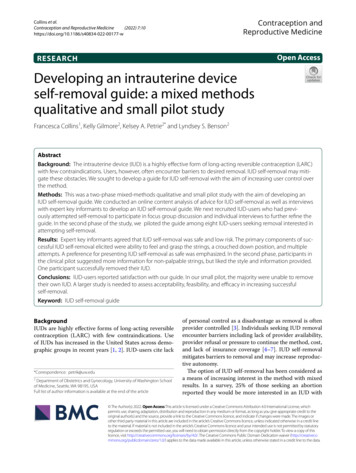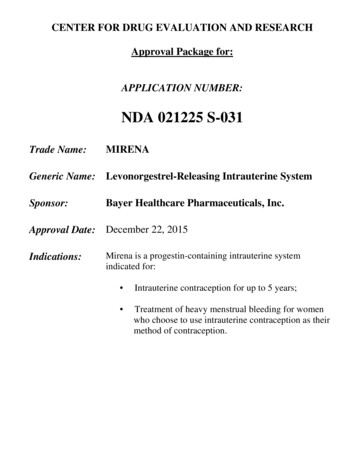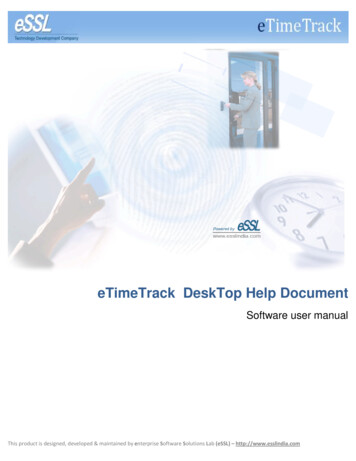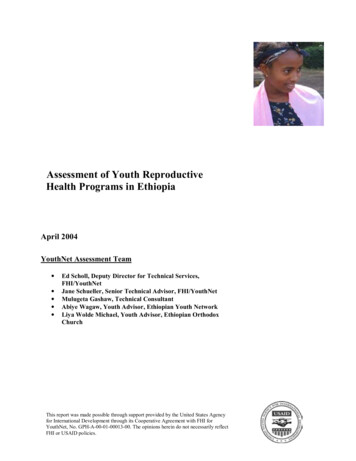
Transcription
Contraception andReproductive MedicineCollins et al.Contraception and Reproductive Medicine(2022) 7:10https://doi.org/10.1186/s40834-022-00177-wOpen AccessRESEARCHDeveloping an intrauterine deviceself‑removal guide: a mixed methodsqualitative and small pilot studyFrancesca Collins1, Kelly Gilmore2, Kelsey A. Petrie2* and Lyndsey S. Benson2AbstractBackground: The intrauterine device (IUD) is a highly effective form of long-acting reversible contraception (LARC)with few contraindications. Users, however, often encounter barriers to desired removal. IUD self-removal may mitigate these obstacles. We sought to develop a guide for IUD self-removal with the aim of increasing user control overthe method.Methods: This was a two-phase mixed-methods qualitative and small pilot study with the aim of developing anIUD self-removal guide. We conducted an online content analysis of advice for IUD self-removal as well as interviewswith expert key informants to develop an IUD self-removal guide. We next recruited IUD-users who had previously attempted self-removal to participate in focus group discussion and individual interviews to further refine theguide. In the second phase of the study, we piloted the guide among eight IUD-users seeking removal interested inattempting self-removal.Results: Expert key informants agreed that IUD self-removal was safe and low risk. The primary components of successful IUD self-removal elicited were ability to feel and grasp the strings, a crouched down position, and multipleattempts. A preference for presenting IUD self-removal as safe was emphasized. In the second phase, participants inthe clinical pilot suggested more information for non-palpable strings, but liked the style and information provided.One participant successfully removed their IUD.Conclusions: IUD-users reported satisfaction with our guide. In our small pilot, the majority were unable to removetheir own IUD. A larger study is needed to assess acceptability, feasibility, and efficacy in increasing successfulself-removal.Keyword: IUD self-removal guideBackgroundIUDs are highly effective forms of long-acting reversiblecontraception (LARC) with few contraindications. Useof IUDs has increased in the United States across demographic groups in recent years [1, 2]. IUD-users cite lack*Correspondence: petrik@uw.edu2Department of Obstetrics and Gynecology, University of Washington Schoolof Medicine, Seattle, WA 98195, USAFull list of author information is available at the end of the articleof personal control as a disadvantage as removal is oftenprovider controlled [3]. Individuals seeking IUD removalencounter barriers including lack of provider availability,provider refusal or pressure to continue the method, cost,and lack of insurance coverage [4–7]. IUD self-removalmitigates barriers to removal and may increase reproductive autonomy.The option of IUD self-removal has been considered asa means of increasing interest in the method with mixedresults. In a survey, 25% of those seeking an abortionreported they would be more interested in an IUD with The Author(s) 2022. Open Access This article is licensed under a Creative Commons Attribution 4.0 International License, whichpermits use, sharing, adaptation, distribution and reproduction in any medium or format, as long as you give appropriate credit to theoriginal author(s) and the source, provide a link to the Creative Commons licence, and indicate if changes were made. The images orother third party material in this article are included in the article’s Creative Commons licence, unless indicated otherwise in a credit lineto the material. If material is not included in the article’s Creative Commons licence and your intended use is not permitted by statutoryregulation or exceeds the permitted use, you will need to obtain permission directly from the copyright holder. To view a copy of thislicence, visit http:// creat iveco mmons. org/ licen ses/ by/4. 0/. The Creative Commons Public Domain Dedication waiver (http:// creat iveco mmons. org/ publi cdoma in/ zero/1. 0/) applies to the data made available in this article, unless otherwise stated in a credit line to the data.
Collins et al. Contraception and Reproductive Medicine(2022) 7:10option for self-removal [8]. However, another study foundthat there was no difference in IUD uptake, satisfaction,or discontinuation when information of self-removal waspresented attributed in part to high knowledge of IUDself-removal among the study population at baseline [9].There is indeed a great deal of information about IUDself-removal available to the public online. A recent separate content analysis found that 58 online videos discussing LARC self-removal had nearly 4 million views [10].One multi-site study evaluated interest and experienceswith IUD self-removal. While only 19% of participantssuccessfully removed their own IUD, the majority wouldrecommend self-removal to a friend (58%) and attemptself-removal in the future (54%) [11]. The study utilized aone-page guide for self-removal instructing participantsto wash their hands with soap, find a position to bestreach the strings, and to pull the strings gently and firmlynoting that the IUD should come out with a gentle tug[11].We aimed to develop a guide rooted in the advice andexperience of IUD users who had previously attemptedself-removal and key expert informant opinion. Whilethere is certainly information available online aboutself-removal, we sought to create a single consolidatedand comprehensive resource in an easily accessible anduser-friendly format using gender neutral terminologyand graphics. We completed the work to develop thisguide prior to the COVID-19 pandemic and it has sincebecome increasingly relevant. Notably, in the early stagesof the pandemic, the American College of Obstetriciansand Gynecologists discouraged LARC removal insteadadvising, "Existing IUD and implant users who seekremoval and replacement of their contraceptives shouldbe counseled about extended use of these device" [12].These new challenges to accessing comprehensive reproductive healthcare underscore the importance of a comprehensive tool to assist in IUD self-removal as a meansof increasing reproductive autonomy.MethodsThis was a two-phase mixed-methods qualitative andsmall pilot study that took place from July 2016-December 2017. All phases were approved by the University ofWashington Human Subjects Division. The first phaseof this study had two parts. First, using an online content search and expert key informant interviews an initial version of the IUD self-removal guide was developed.Second, IUD users who had previously attempted selfremoval were recruited to participate in focus groupsor individual interviews about their experience attempting self-removal and thoughts on our IUD self-removalguide. Based on their feedback, the guide was adaptedPage 2 of 7and then piloted in a small convenience sample in phasetwo. The phases of the study are summarized in Fig. 1.Phase I: qualitative development of an IUD self‑removalguideThe first phase included first both an online contentsearch and expert key informant interviews to developan initial version of the self-removal guide followed byinterviews with IUD users who had previously attemptedself-removal for further refinement. We developed a toolto collect data from women presenting information andadvice on IUD self-removal online from YouTube, Facebook, personal blogs, and websites. The tool collectedinformation on the reason for self-removal, a descriptionof the process they tried to self-remove, an indicationof whether they had ever felt their strings before, theiradvice to others wishing to attempt self-removal, whetherthey were successful, and an analysis of the commentsposted and whether they indicated viewers/readers foundthe advice helpful or unhelpful.For our expert key informants, we recruited family planning providers and experts in the Seattle area usingpersonal connections and snowball sampling. Keyinformants were recruited from community-basedclinics, academic medical centers, private OB/GYNpractices, the public health department, Planned Parenthood, midwifery practices, and reproductive andsexual health advocacy and research non-profits. Weused a semi-structured interview guide for key informants that covered their professional opinion on thesafety and community need for IUD self-removal, theirexperience with patients who have attempted IUD selfremoval, their advice for instructing women to removetheir own IUDs, their concerns about risks and safety,and their advice on how to best present information onself-removal.We analyzed data from the online search and interviews using a content analysis approach identifying common themes in Dedoose qualitative software to developthe first version of the self-removal guide.Phase I: refinement of the developed IUD self‑removalguideAfter using the qualitative data from the online contentsearch and key expert informant interviews to develop afirst version of the IUD self-removal guide, we presentedthis version of the self-removal guide to IUD-userswho had attempted self-removal for further refinementin focus groups and semi-structured interviews. Werecruited IUD users who had previously tried to removean IUD via online, print and social media advertisementsto participate in a focus group or interview about theirexperience. Women had to be English-speaking, 18 years
Collins et al. Contraception and Reproductive Medicine(2022) 7:10Page 3 of 7Fig. 1 Guide development flowof age or older and had ever attempted to remove theirown IUD; they did not need to be successful in theirattempt. In both settings, we asked the same semi-structured questions covering reasons for attempting IUDself-removal, experience with self-removal, concernsprior to attempting self-removal, and feedback on theguide. Participants were given a 35 gift card.We analyzed focus group and interview transcriptsin Dedoose qualitative software. Two members of theresearch team developed an a priori codebook from focusgroup and interview transcripts that was applied to alltranscripts to elucidate common themes. Our initial goalwas to reach up to 30 research participants, however, wereached thematic saturation after hearing from eight participants about their IUD self-removal attempts. Fromthis analysis we designed version two of the self-removalguide incorporating their comments on their experiencewith self-removal and direct feedback on the guide.Phase II: piloting the self‑removal guideWe approached patients seeking IUD removal at theUniversity of Washington Family Planning Clinic. Afterproviding informed consent, IUD-users completed a prestudy questionnaire. They were then given 10–15 minalone in an exam room to attempt self-removal usingthe online guide. Patients could indicate they were done
Collins et al. Contraception and Reproductive Medicine(2022) 7:10attempting self-removal at any time. If the patient wasunsuccessful, the physician entered and removed theIUD. Participants then completed the post-study questionnaire about whether they were successful, theirlevel of pain, and their feedback on the guide. Providersrecorded if participants experienced any adverse events.Participants were given 35 for their time.ResultsWe collected data from six websites where IUD-usersshared their own successful IUD self-removal experiences. We recruited 12 expert key informants (threepublic health professionals, a nurse practitioner, fourmidwives, and four physician expert key informants).Three primary components of successful IUD selfremoval emerged from this analysis: 1) ability to feeland grasp the strings 2) a crouched down position thatincluded “bearing down” 3) multiple attempts using different body positions.Expert key informants agreed that IUD self-removalwas safe and low risk. They recommended those interested in IUD self-removal wash their hands, feel for theirstrings, and pull down and out firmly. Three medical professionals suggested wearing gloves to better be able togrip the strings. All twelve suggested including information about need for a different method of birth control iffertility was not desired.We then held one focus group with five participantsand three in-depth interviews with individuals unableto attend the focus group, participant demographics aresummarized in Table 1. They indicated a preference foran online guide over a pamphlet. Participants indicateda preference for presenting self-removal without overcomplication or repeat warnings to seek medical care.The most commonly stated reasons for IUD self-removalwere desired fertility, cost, and long appointment waittimes.Version two of the IUD self-removal guide was createdas a website in collaboration with a graphic design student with a short infographic video and step-by-step process. Representative images are included as Fig. 2. EightIUD-users desiring removal participated in the clinicalpilot using this version, their demographics are summarize in Table 2.All pilot participants indicated that they liked theguide, found it helpful and easy to understand, and likedthe multimedia elements including the video. Whenasked what they liked best about the guide, the majority of participants cited the simplicity, the icons, and thevideo. They suggested more tips on finding and grippingthe strings. One participant was successful in removingtheir IUD. The remaining participants had their IUDsremoved by providers. String lengths were records andPage 4 of 7Table 1 Demographics of focus group and interview participantswith prior self-removal attemptVariable% (N)Age18–2913 (1)30–3963 (5)40–4913 (1)50–5913 (1)Race/EthnicityWhite75 (6)Black-Hispanic/Latinx13 (1)Asian/Pacific Islander13 (1)Native American-Highest level of EducationHigh School13 (1)Some College13 (1)Associate’s Degree13 (1)Bachelor’s Degree38 (3)Master’s Degree25 (2)Advanced Graduate Degree-Annual Household IncomeUnder 25,000- 25,000— 39,000- 40,000— 50,00038 (3) 50,000— 75,00025 (2) 75,000— 100,00013 (1)Over 100,00013 (1)the average length was 5.8 cm. All participants reportedthat they felt “somewhat comfortable” or “comfortable”attempting IUD self-removal. There were no adverseevents.DiscussionWe developed an online IUD self-removal guide usinginput from IUD-users who had successfully removedtheir own IUDs and expert key informants. The primarycomponents of successful IUD self-removal elicited wereability to feel and grasp the strings, a crouched downposition, and multiple attempts. A preference for presenting IUD self-removal as safe was emphasized. Wethen piloted our guide among a small convenience sample in our clinic. Participants in our small clinical pilotliked the overall design, feel, and content of the onlineIUD self-removal guide. They suggested including moreadvice on finding IUD strings, feedback we have used tofurther refine the guide.Currently, the online IUD self-removal guide is a website containing an introduction to IUD self-removal;disclaimers for those interested in attempting; a video
Collins et al. Contraception and Reproductive Medicine(2022) 7:10Page 5 of 7Fig. 2 IUD self-removal guide website representative content, IUD-self removal steps with example of trouble-shootinganimation with a step-by-step guide; a page dedicated to frequently asked questions including troubleshooting for non-palpable strings; information onbirth control options; and resources for those desiring pregnancy after removal. It consolidates theadvice from content analysis of IUD-users who havepreviously attempted self-removal and key expertinformants to present IUD self-removal as safe andfeasible. It presents this information with genderneutrality.
Collins et al. Contraception and Reproductive Medicine(2022) 7:10Table 2 Demographics of pilot participantsVariable% (N)Race/EthncitiyWhite86 (6)Black-Hispanic/Latinx-Asian/Pacific Islander-Native American14 (1)Highest Level of EducationHigh School-Some College14 (1)Associate’s Degree-Bacehelor’s Degree43 (3)Advanced Graduate Degree43 (3)Annual Household IncomeUnder 25,00014 (1) 25,000 – 39,000- 40,000 – 50,000- 50, 000 – 75,00014 (1) 75,000 – 100,00043 (3)Over 100,00029 (2)Participants in our small clinical pilot liked the overalldesign, feel and content of the online IUD self-removalguide but the majority were unable to self-remove theirIUD. Our rates of successful self-removal (12.5%) arelower than previously found (19%) [10], however we werelimited by a very small convenience sample size. Further,within our small convenience sample, the average stringlength was lower than in the work by Foster et al. (5.8 cmversus 6.7 cm), who also found a 50% increase in successrate of IUD self-removal with each 0.5 cm increase instring length.The strengths of our study include the mixed methodsto incorporate available online content as well as iterativefeedback of key expert informants and IUD-users. Weaknesses of our study include the small sample size andconvenience sample of those scheduled for IUD removalin clinic. Additionally, our expert key informants andpilot participants were primarily white, well educated,and in their 30’s.ConclusionsA larger study of the online IUD self-removal guide isneeded to evaluate feasibility, acceptability, and effectiveness among a diverse group of IUD-users seeking selfremoval information including those in a non-clinicalsetting. Ultimately, a simple resource aiding IUD-users inself-removal may be used as a tool to increase reproductive autonomy and to normalize patient-provider conversations around self-removal.Page 6 of 7AbbreviationsLARC : Long acting reversible contraception; IUD: Intrauterine Device.AcknowledgementsWe would like to thank Olivia Carter for her graphic design expertise in generating the IUD-self removal website, images, and video content.Authors’ contributionsFC, KG, and LB designed the study. FC and KG collected and analyzed the data.FC, KG, LB, and KP interpreted the study findings. KP drafted the manuscriptfor publication and all authors edited and approved the final manuscript.FundingThis work was supported by a Society of Family Planning Grant [SFPRF10-16].We have no financial competing interests to declare.Availability of data and materialsUpon request.DeclarationsEthics approval and consent to participateWe obtained approval through the University of Washington InstitutionalReview Board. All participants provided informed consent.Consent for publicationNot Applicable.Competing interestsThe authors declare that they have no competing interests.Author details1University of Washington School of Public Health, 1959 NE Pacific StreetSeattle, Seattle, WA 98195, USA. 2 Department of Obstetrics and Gynecology,University of Washington School of Medicine, Seattle, WA 98195, USA.Received: 24 April 2022 Accepted: 31 May 2022References1. Kavanaugh ML, Pliskin E. Use of contraception among reproductive-agedIUD-users in the United States, 2014 and 2016. F&S Reports. 2020;1(2):83–93. https:// www. ferts tertr eports. org/ artic le/ S2666- 3341(20) 30038-6/ fullt ext.2. Finer LB, Jerman J, Kavanaugh ML. Changes in use of long-actingcontraceptive methods in the United States, 2007–2009. Fertil Steril.2012;98(4):893–7. https:// doi. org/ 10. 1016/j. fertn stert. 2012. 06. 027.3. Asker C, Stokes-Lampard H, Beavan J, Wilson S. What is it about intrauterine devices that IUD-users find unacceptable? Factors that makeIUD-users non-users: a qualitative study. J Fam Plann Reprod Health Care.2006;32(2):89–94. https:// doi. org/ 10. 1783/ 14711 89067 76276 170 PMID:16824298.4. Amico JR, Stimmel S, Hudson S, Gold M. “ 231 to pull a string!!!” American IUD-users’ reasons for IUD self-removal: an analysis of internet forums.Contraception. 2020;101(6):393–8. https:// doi. org/ 10. 1016/j. contr acept ion. 2020. 02. 005 Epub 2020 Feb 21 PMID: 32088175.5. Amico JR, Bennett AH, Karasz A, Gold M. “She just told me to leave it”:IUD-users’s experiences discussing early elective IUD removal. Contraception. 2016;94(4):357–61. https:// doi. org/ 10. 1016/j. contr acept ion. 2016. 04. 012 Epub 2016 Apr 27 PMID: 27129934.6. Amico JR, Bennett AH, Karasz A, Gold M. Taking the provider “out of theloop:” patients’ and physicians’ perspectives about IUD self-removal.Contraception. 2018;98(4):288–91. https:// doi. org/ 10. 1016/j. contr acept ion. 2018. 05. 021 Epub 2018 Jun 2 PMID: 29870685.7. Armstrong E, Gandal-Powers M, Levin S, Kimber-Kelinson A, LuchowskiA, Thompson K. Intrauterine devices and implants: a guide to reimbursement. https:// larcp rogram. ucsf. edu/. July 2015. Accessed 9/8/21.8. Foster DG, Karasek D, Grossman D, Darney P, Schwarz EB. Interest in usingintrauterine contraception when the option of self-removal is provided.
Collins et al. Contraception and Reproductive Medicine(2022) 7:10Page 7 of 7Contraception. 2012;85(3):257–62. https:// doi. org/ 10. 1016/j. contr acept ion. 2011. 07. 003 Epub 2011 Aug 17 PMID: 22067772.9. Raifman S, Barar R, Foster D. Effect of knowledge of self-removability ofintrauterine contraceptives on uptake, continuation, and satisfaction.Womens Health Issues. 2018;28(1):68–74. https:// doi. org/ 10. 1016/j. whi. 2017. 07. 006 Epub 2017 Sep 4. PMID: 28882549.10. Kathleen Broussard, Andréa Becker. Self-removal of long-acting reversiblecontraception: A content analysis of YouTube videos. Contraception.2021;104(6):654–658. https:// doi. org/ 10. 1016/j. contr acept ion. 2021. 08. 002. Epub 2021 Aug 13. PMID: 34400154; PMCID: PMC8592268.11. Foster DG, Grossman D, Turok DK, Peipert JF, Prine L, Schreiber CA,Jackson AV, Barar RE, Schwarz EB. Interest in and experience with IUD selfremoval. Contraception. 2014;90(1):54–9. https:// doi. org/ 10. 1016/j. contr acept ion. 2014. 01. 025 Epub 2014 Feb 7 PMID: 24613370.12. AM. Kaunitz. COVID-19 gynecology practice recommendations fromACOG. NEJM J Watch Womens Health; 2020. https:// www. jwatch. org/ na513 12/ 2020/ 04/ 16/ covid- 19- gynec ology- pract ice- recom menda tions- acog. Accessed 30 Nov 2021.Publisher’s NoteSpringer Nature remains neutral with regard to jurisdictional claims in published maps and institutional affiliations.Ready to submit your research ? Choose BMC and benefit from: fast, convenient online submission thorough peer review by experienced researchers in your field rapid publication on acceptance support for research data, including large and complex data types gold Open Access which fosters wider collaboration and increased citations maximum visibility for your research: over 100M website views per yearAt BMC, research is always in progress.Learn more biomedcentral.com/submissions
in Dedoose qualitative software. Two members of the research team developed an a priori codebook from focus group and interview transcripts that was applied to all transcripts to elucidate common themes. Our initial goal was to reach up to 30 research participants, however, we reached thematic saturation after hearing from eight par-










